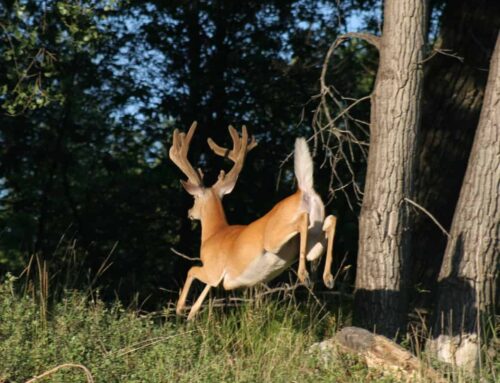
Create Browse
A honey hole that had produced a bunch of bucks over the years went cold on my Virginia land. Deer quit using the area, and it didn’t take me long to figure out why. The woods had simply grown too old. There was a heavy, dark canopy and little vegetation on the ground.
A couple of buddies and I fired up chainsaws and dropped most of the scrub pole timber in a half-acre strip. Today briars and berry bushes grow everywhere in there. It’s once again a staging area for deer and one of my favorite bowhunting spots.
The more “browse cuts” you scatter across a property the better. Don’t be timid. Other than sparing your top mast-producing trees, you really can’t cut too much. Drop trees to create small strips and clearings that will receive lots of sunlight. Forbs and grasses will pop up almost overnight. Brambles, vines, and woody stems and shoots will grow thick for a few years. Beginning this fall, hang tree stands near the browsing spots and you’ll see deer.
Work with a browse-cut plan that takes into account the prevailing winds and deer movements in an area. For example, after sawing some trees stack the tops in a spot where most days they’ll block does and bucks from coming in downwind of one of your stands. Force deer to turn and walk in on upwind side where they won’t smell you.
Create Cover
Big deer, like big bass, are drawn to structure. With that in mind, create pockets of cover across your land and close to crop fields, white-oak flats and other established food sources. Saw and drop trees in spots that are, say, 50 to 75 yards across. Simply let the treetops lie, or cut and stack some logs and tops into dense piles or strips. Each of the little cover/browse structures will attract does. Bucks know that, and during the rut they’ll bounce from pocket to pocket looking for the hotties.
Create Brush Piles
One way to create both feed and cover for deer is with “living brush piles.” With your saw, cut partway into 3- to 6-inch non-value trees and shrubs until they topple over, but don’t sever them from the stumps. Many of the trees will live for a year or two and provide succulent browse for deer. After that and for years to come the strips of felled timber will offer great cover for does and bucks.
Road Work
Hop on your side-by-side or ATV, load up your chainsaw and tools, and ride the boundaries of your property. Stop here and there to cut scrub trees and logs until you establish a full perimeter trail around where you hunt. While you’re at it, saw deadfalls or brushy overgrowth and open old roads and quad trails on the interior of your woods. Later this summer and into the fall, you can ride the perimeter roads and keep tabs on your boundaries if you’ve had trespassing problems. The clean trails inside and outer will provide quick and quiet access to your tree stands next fall.





